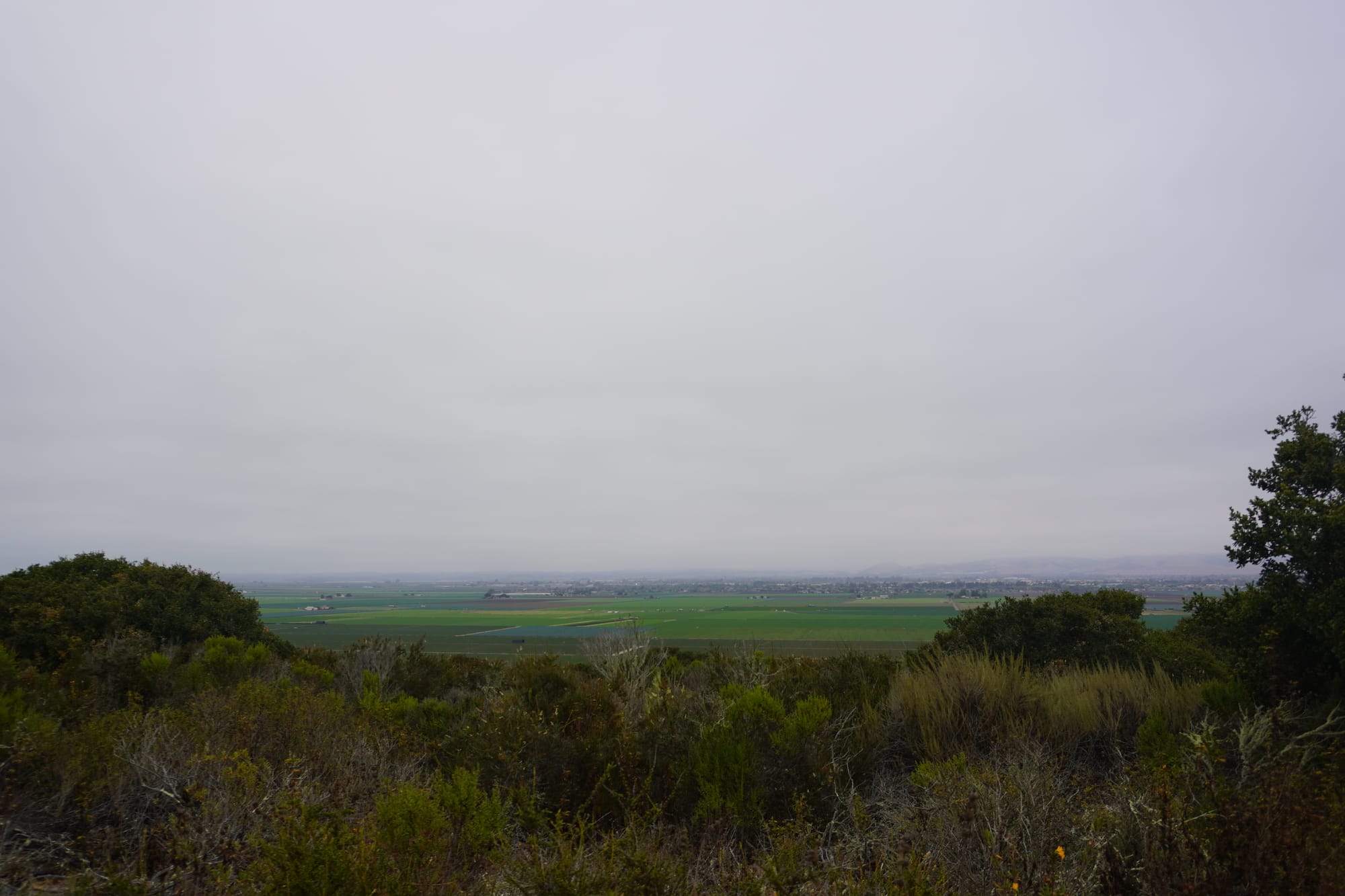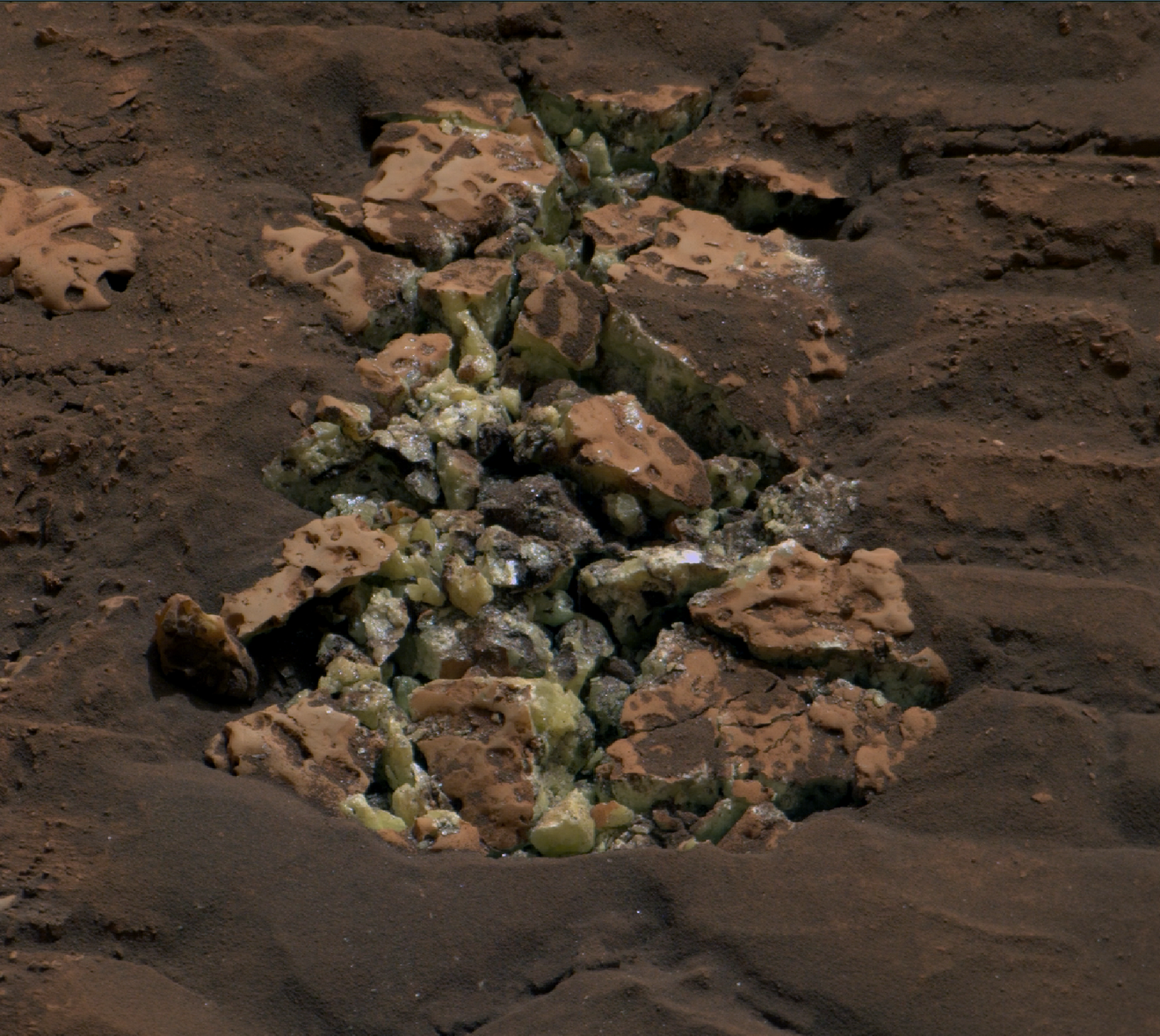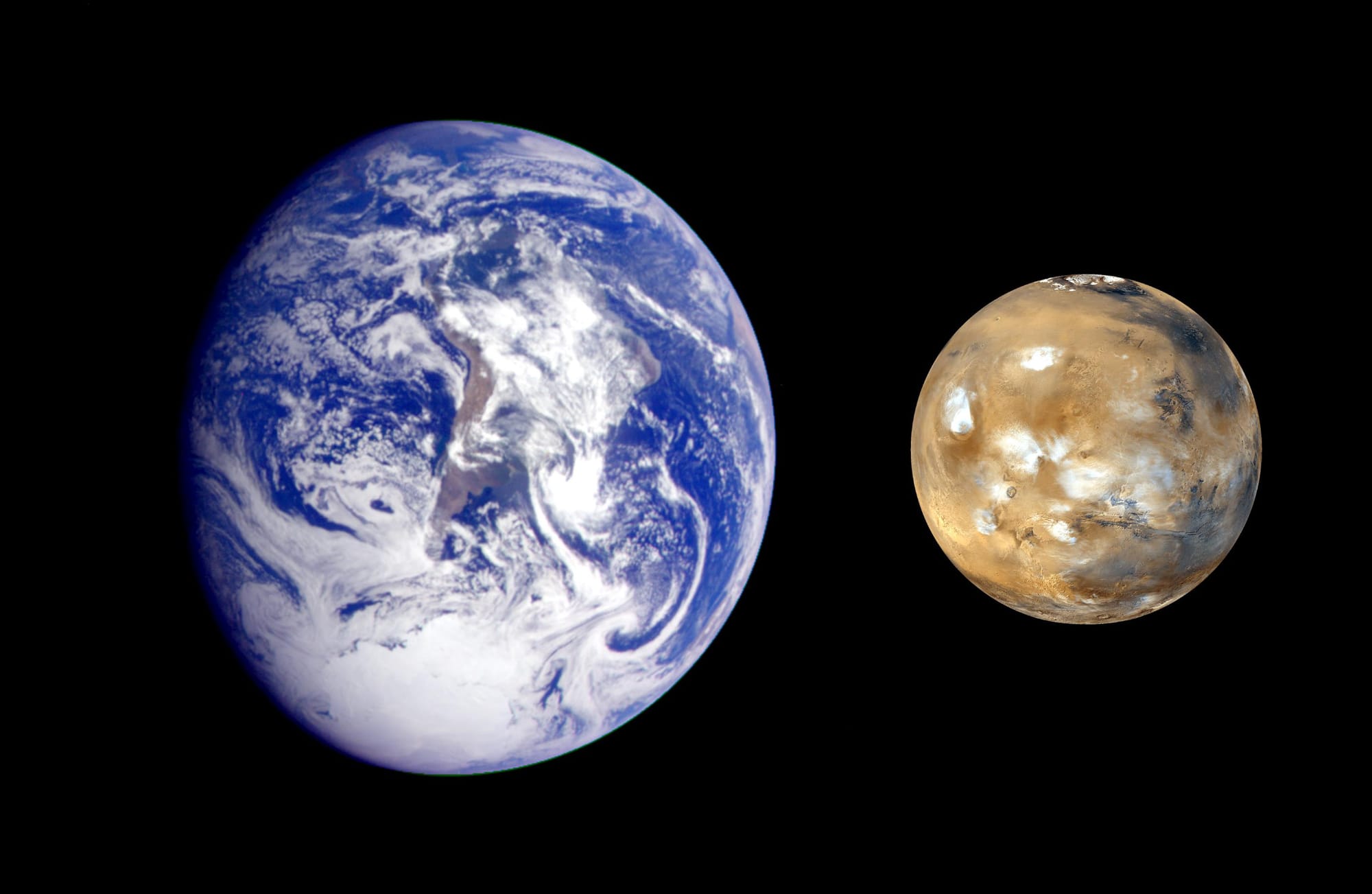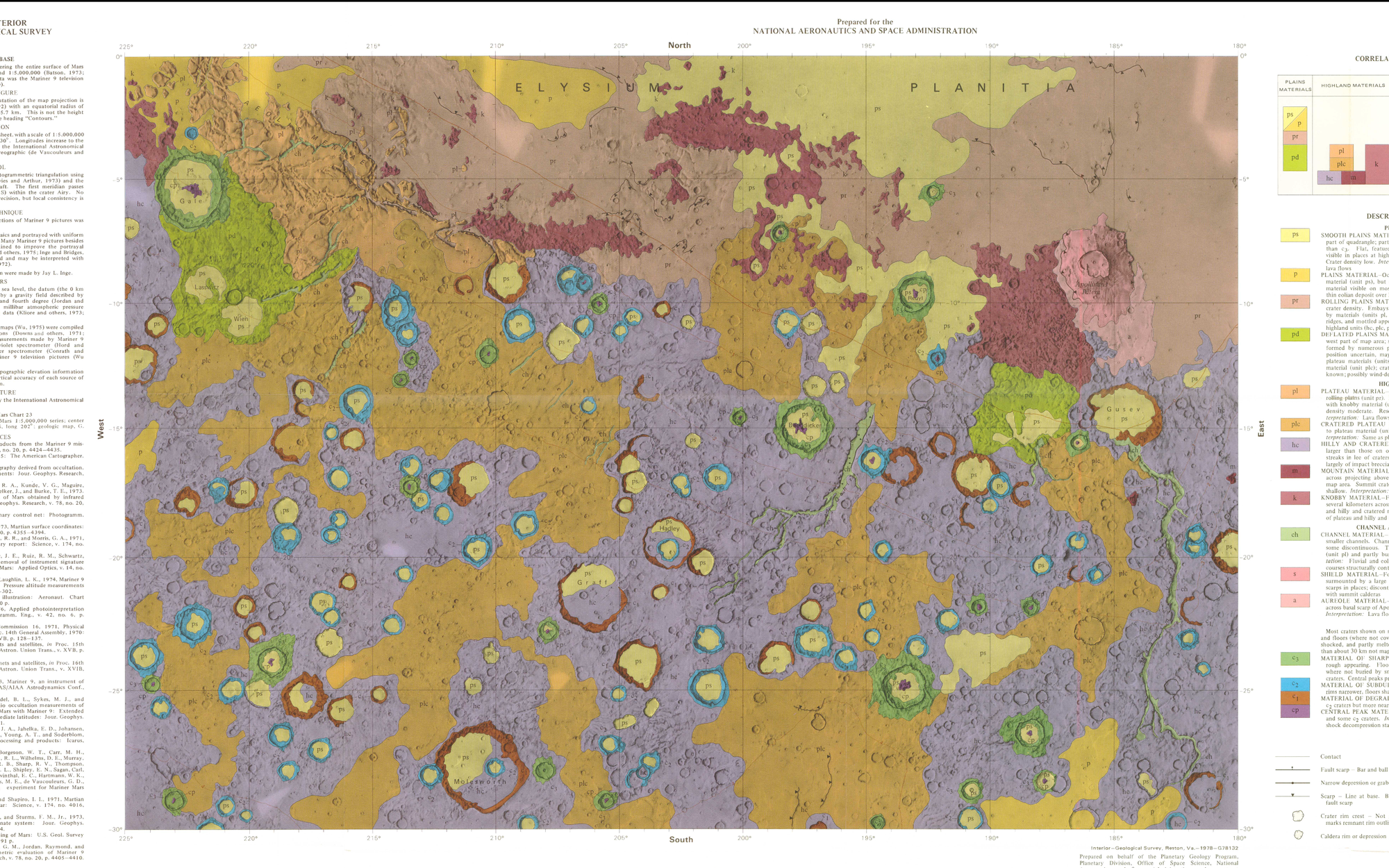not so foreboding dirt: recent discoveries on mars!
welcome to A Teetering Vulture! a newsletter about various science stuff as well as the life happenings of its author, Taylor.

Speculative and science fiction author Ursula K. Le Guin once said that Northern California dirt is a difficult dirt. That it is, at least according to the fictional Kesh society in her novel Always Coming Home, not a rich, openminded, amenable soil, but poor, opinionated, and cranky dirt.
It was while I was walking on California dirt, in the dry summer chaparral to the east of Monterey, not too far from the north, in the central, coastal part of the state, that I first began thinking about Mars and its dirt. I likely wouldn’t have thought of Mars at all if it weren’t for Madison, who said she’d like me to write about Mars so she could understand why it was “weird that we had just discovered sulfur crystals there.” I was apprehensive about the idea, at first. We were hiking at Fort Ord National Monument at the time of this conversation, traipsing through the dust past manzanitas and live oaks and coyote brush. Quails were calling their watery burbly calls from their places hidden within the grass, a juvenile hawk was hovering over the golden hills looking for prey or maybe just playing in invisible channels of air.
Le Guin also called California a generous land. She said it was not lush, not soft, and not gentle, but still that it was generous. The land in the Salinas Valley beside Fort Ord is often called the Salad Bowl of the United States, for all the lettuce and strawberries and artichokes and other produce it lends the country each year. So maybe the soil isn’t the most amicable, but when worked by skilled hands, it isn’t afraid to give to us. It yields life even if it’s rather austere and located in a mercurial climate where drought is far from unheard of and where walls of dense fog roll in off the ocean each evening, looming inexorable reminders of the marine engine driving it’s austerity.
But I’m assuming that when Le Guin called California’s dirt poor, she had in mind other Earthen soils—that those were her points of comparison for a book that is incredibly focused on Earth. When I started doing research for this post, I found the authors of one paper calling the surface of Mars “barren, foreboding, and likely uninhabitable.” Compared with the dirt on Mars, I don’t think many would argue with you if you said that California’s dirt could indeed be called lush, soft, and gentle. Almost every surface on Earth, in fact, is teeming and wealthy with life, in comparison to Mars—is relatively lush, soft, gentle. This is what has always unnerved me slightly about Mars and deterred me from studying it in any detail. Its desolation. Its lifeless lack of comfort and warmth.



California grasses and hills shrouded in fog; Salinas Valley and agricultural fields; California's hills by @NathanFowkesArt on Twitter
I think I probably love space an average amount. There are many people who love space a whole lot more than me, and know much, much more about it. There are also many people who love it a lot less than I do. I have taught courses of study about the universe, but I have a background in biology. I am comforted and challenged by my own planet enough, by the hawk hovering in the sky and the manzanitas persisting in the dust, that I don’t often find myself more than momentarily transfixed by space. But Madison wanted to know about sulfur on Mars. And I did not have a total dearth of curiosity, either.
So, initially, I found this out: recently, the Mars rover called Curiosity ran over a rock. The rock split open as a result and revealed yellow elemental sulfur crystals, the first to ever be found on the planet. Sulfur- and sulfate-containing minerals and compounds exist all across and within the planet, but not pure, bright yellow, odorless sulfur. Curiosity has been roving around the planet for twelve years and has traversed nearly twenty total miles, slowly and meticulously investigating the geology of its surroundings. Because of Curiosity and its suite of scientific instruments and cameras, scientists have been able to create a highly detailed map of the rocks, sediments, and geological features in the area—and this sulfur was not predicted on that map. It raises questions not only about the history that brought that sulfur stone to that place, but the history that brought an entire field of elemental sulfur stones there, which Curiosity’s MastCam camera discovered soon after its cracking open of the first stone. Some kind of volcanic activity may be one beginning of an explanation, but so far it remains a mystery.


Sulfur crystals imaged by Curiosity; Earth and Mars depicted side-by-side (Credit: NASA/JPL-Caltech/MSSS)
360 degree view of the field of sulfur stones on mars.
Gaining this tiny sliver of knowledge about Mars was enough to crack open a fissure of curiosity in my mind about the planet—and soon my reservations about Mars had almost completely dissolved. Mars is—and this is absolutely unsurprising to anyone who has ever been remotely interested in it—a fascinating place. And we humans know SO MUCH about it.
Over the years, our planet has sent 18 orbiters—that is, spacecraft that are designed to operate out in space, to orbit some celestial body—to Mars. Seven Mars orbiters still remain active, where in their orbits they are imaging the planet, gathering multifarious data. India has plans to send another orbiter, Mars Orbiter Mission-2, or MOM-2, to Mars late this year. In addition to telescopes, these orbiters, beginning with NASA’s launch of Mariner 9 in 1971, have helped us map the entire surface of the planet. The United States Geological Survey used data collected by Mariner 9 to divide the planet into 30 topographical regions, each with it’s own characteristic feature. These 30 regions are known as quadrangles, and there are rather beautiful, colorized maps of each one of them on the USGS’ website that depict the fields of impact crators, vast plains, channels, knobby regions, mountains, and all the other diverse geologic structures of the planet.
We have also landed six rovers successfully on Mars: Sojourner (1999), Spirit (2004), Opportunity (2004), Curiosity (2012), Perseverance (2021), and Zhurong (2021). Curiosity and Perseverance are still actively exploring—Curiosity in the Aeolis quadrangle in the southeast, in an impact crater called Gale Crater, and Perseverance in Jezero Crater in the eastern portion of the equatorial Syrtis Major quadrangle. At the center of Gale Crater is Mount Sharp, a 3-mile high mountain (for comparison, think Mount Rainier in Washington or Mount Shasta in Northern California) thought to have formed from a combination of impact decompression and slow sediment accumulation. Both locations were chosen as rover landing and exploration sites because they are thought to be ideal places to look for signs of life—in the past or present—and to assess just how habitable conditions are now, or were in the history of the planet.

Mars has about a 4.5 billion year old history, and just like for Earth—and in fact using many of the same approaches we have in place for Earth—we have sectioned that history into different periods based on its dominant geological and atmospheric conditions. In its earliest years, the Pre-Noachian and Noachian Periods stretching until 3.7 billion years ago, the planet was highly volcanically active and constantly bombarded with material from space. In the subsequent Hesperian Period, which lasted until 3 billion years ago, catastrophic flooding was added to the mix of vulcanism and bombardment, as the planet was supplied with water from asteroids and meteors from space and from volcanic outgassing. In these eras, the sedimentary cycle on the planet was being heavily influenced by each of these three processes, and resulted in the geological trends we have discovered in the rock record on the planet in the last several decades. Mars is a one plate planet that lacks plate tectonics and has a continuous basaltic crust; basalt is a volcanic rock, and its ubiquitous presence in the crust means that much of the planet’s sediments derive from it. In other words, the planet’s lithosphere largely has a basaltic provenance, or origin. The planet’s geology is also dominated by clays, acidic sulfate minerals, and the iron oxides that give Mars its red tinge.
Progressive desiccation of the planet has been occurring since the early Amazonian Period, which is the Period spanning from 3 billion years ago to the present. Where all the water that was once on Mars’ surface has gone is a mystery still being solved, and something I’ll address in detail later on, but currently, the planet is considered “hyperarid,” or incredibly dry and desert-like, as well as frigid (diurnal temperatures recorded on Perseverance range from -117 degrees Fahrenheit (-83 degrees Celsius) to 40 degrees (4 degrees Celsius)—and that’s just during the day!), windy (an average of one dust devil passes over the top of Perseverance every day, just to give you an idea), with a thin atmosphere comprised mostly of carbon dioxide. Polar caps consisting in part of frozen water do however remain on the planet. Though, as we learn more and more about Mars—and this makes sense about most things we learn more and more about—we understand that it’s impossible to say that it is only one thing, that it is a planet that looks and behaves in one way. There are many complex regional, annual, and seasonal variations caused by solar activity fluctuations, periodic dust storms, and the oscillations of the planet’s plane of axis that influence what it's doing in different places and how we characterize it. Weathering processes like wind erosion in the present, as well as deposition of sediments via wind, are variable from place to place. It’s history has included salt weathering, great floods carving lakes and rivers, permafrost processes, thermal stress, long durations of volcanic activity, and even some uplift and rifting. In general, though much of how we view Mars’ geology is heavily influenced by our study of Earth’s geology, it is a vastly different world, with diverse pockets of history and nuances to its existence we likely haven’t considered yet.

“We should be guided by our knowledge gained from the study of Earth but must take care to not impose our Earth-centric biases too strongly, lest we obscure a novel perspective,” say the authors of a 2019 review of what was then known of the sedimentary cycle of early Mars. So, even though we have a lot of evidence for certain ideas and hypotheses about the environments of Mars’ past, we have to be careful. The deputy principal investigator of the MastCam for Curiosity, Dr. Rebecca Williams, working with the Planetary Science Institute in Tucson, Arizona, has extensively studied the stratigraphy of Gale Crater and published papers about its paleoenvironments. By conducting comparative studies of rivers, river deltas, and alluvial fans around the world here on Earth, she has been able to conclude based on geomorphic and strata data from Curiosity that Gale has analogs to what we see in these Earthen environments. Gale in fact likely has a fluvial, lacustrine, and deltaic history. There are signs of ancient rivers and lakes and deltas everywhere in Curiosity’s field of view. And yet there are also sulfur stones, which are unexpected. The stones remind us that we can’t always look to Earth to explain the geology of Mars, and instill a desire to look at things from a wider, more open-minded perspective. To be a geologist studying Mars is to consider possibilities never before considered on Earth.
While researching information on the sulfur stones, I came across a report published that day, on August 12, 2024, in the Proceedings of the National Academy of Sciences. “Liquid water in the Martian mid-crust,” it was titled, and authored by Vashan Wright, Matthias Morzfeld, and Michael Manga. This happened to be the day I had just finished reading a 2021 review that posited a likely explanation for where all the water that existed on Mars billions of years ago ended up disappearing to. Space, that review said. Various changes to the components of the Martian atmosphere facilitated water’s escape from the planet, and this was thought to be a major contributor to the planet’s desiccation. Dust storms kicked water into the air which was then broken apart atom by atom by sunlight and kicked out entirely from the planet. Exchange of water from the polar caps during seasonal cycles also allowed for water to be lifted into the atmosphere and escape. The evidence for this was found in observed changes over time in Mars’ ratio of hydrogen atoms to deuterium atoms. One of hydrogen’s naturally occurring stable isotopes, deuterium is heavier than hydrogen, as it possesses one neutron in comparison to hydrogen’s zero. This means that water comprised of H2O is lighter than water comprised of HDO (which, yes, is a kind of water that naturally exists). Lighter H2O would more readily get kicked into the Martian atmosphere than heavier HDO, meaning that over time, if water was leaving to space, a higher and higher ratio of deuterium to hydrogen would be observed, as the deuterium was more readily left behind. And it turns out that, yes, we do observe this! Deuterium has become enriched in the Martian atmosphere as time has gone on. But coincidentally, at the time I decided to write a paper about Mars, we had just discovered a potentially better explanation for where the majority of water on the planet went—which is a testament to our rapidly evolving perspective of Mars, and to the amazing scale of the challenge of deducing a planet’s past.
A lot of water may have still escaped to space, as the 2021 review suggests. But, based on analysis of new data, there’s also a whole lot of it still present on the planet. But it’s just not really on it. It’s inside of it.
There are oceans worth of water inside it, actually. In 2018, the Mars InSight Lander, one of five non-rover craft to have ever successfully touched down on Martian ground, settled down on a rocky surface and then pressed a seismometer and a heat probe to the planet. And for four years, it simply listened to what was beneath it. Now, we are sifting through all the data it collected, and we’re finding something really cool.
The seismic data suggest that the porous, igneous rock of the Martian crust may be completely saturated with water, enough to fill an ocean one to two kilometers deep that spans the entire surface of the Martian globe. The water in the crust is too deep for us to currently reach—somewhere between 11.5 km and 20 km down—but it gives us an entirely new perspective on the planet, and has altered what we thought we knew about the history of Martian water. That we now know that so much water seeped from the surface downwards, percolating into the depths of the planet and forming a vast reservoir, will allow us to ask new questions about how this happened and what it means—and particularly what it means about the habitability of Mars in the past, present, and future. Water is critical for life as we know it, and so it's possible that clement-enough conditions could exist for life far below the surface. Life exists many kilometers down inside Earth, after all. So it’s not impossible that it could inside Mars, as well.
At the time of this writing, Mars is 140,399,888 miles (or 225,903,420 kilometers) away from Earth. At any given time the planet can be anywhere from 33.9 million miles to 250 million miles away from us. That we have managed to learn so much about this faraway planet since we began our efforts to explore it up close with spacecraft, not even 60 years ago, is simply amazing. What we will go on to discover about Mars in the next 60 years is likely unfathomable.
And what I’ve personally discovered over the course of researching for and writing this post has not at all felt cold and stark, but full of the warmth and comfort of humanity’s need for constant discovery. Back on California’s hills in late July, Madison created an opportunity for me to open my mind to Mars—I’m grateful to her now, grateful to have had the chance to move from not knowing into knowing, a process that always feels a little sacred, and that rarely isn’t fun.
Information for this article was obtained from:
✼ NASA’s Curiosity Rover Discovers a Surprise in a Martian Rock ✼ Where is Perseverance? ✼ PIA15292: 'Mount Sharp' Inside Gale Crater, Mars ✼ Where is Curiosity? ✼ NASA’s Curiosity Searches for New Clues About Mars’ Ancient Water ✼ Dr. Rebecca M. E. Williams ✼ Re-examination of the Martian Lacustrine History ✼ Perseverance rover discovers rock with potential signs of ancient life ✼ India's ambitious 2nd Mars mission to include a rover, helicopter, sky crane and a supersonic parachute ✼ Daily Records of Atmospheric Temperature With Perseverance ✼ Perseverance Mars rover figures out how devils and winds fill the Red Planet's skies with dust ✼ Scientists find oceans of water on Mars. It’s just too deep to tap. ✼ How far away is Mars now? ✼ Atmospheric Loss to Space and the History of Water on Mars ✼ Geology and Stratigraphic Correlation of the Murray and Carolyn Shoemaker Formations Across the Glen Torridon Region, Gale Crater, Mars ✼ The Sedimentary Cycle on Early Mars ✼ Liquid water in the Martian mid-crust ✼ In addition to assistance from the Wikipedia pages for Gale Crater, Exploration of Mars, Jezero Crater, and List of Mars landers ✼